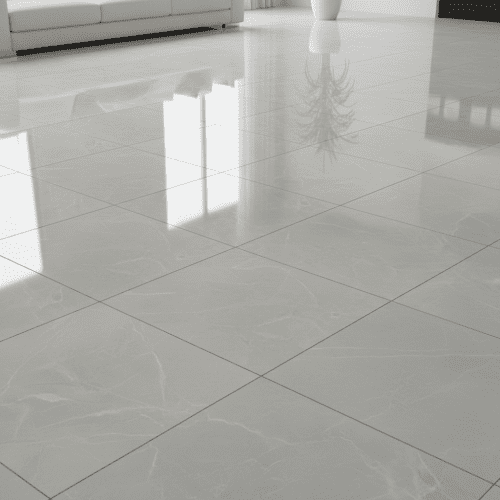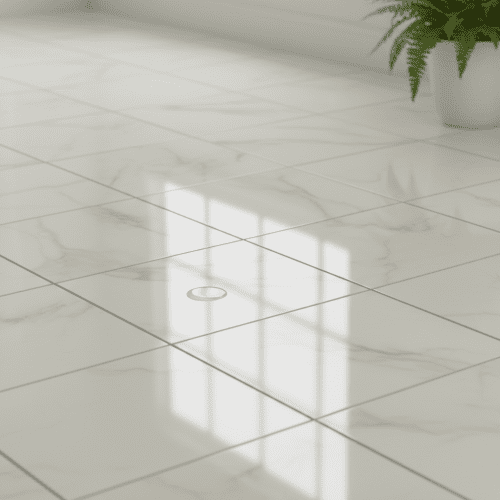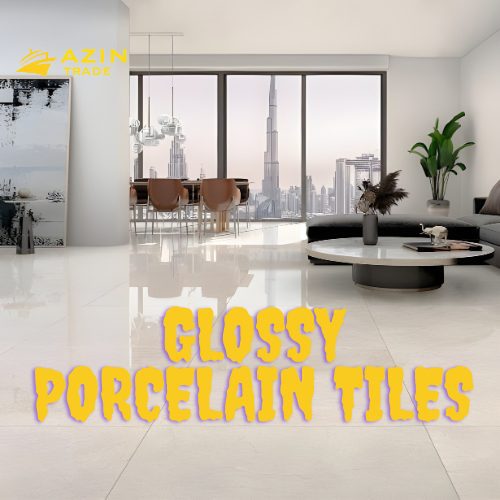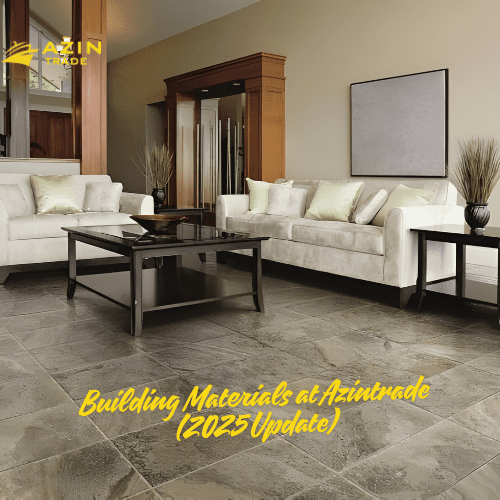Glossy Porcelain Tiles: The Ultimate Guide to Shine, Durability, and Modern Design (2025 Edition)
When it comes to redefining the look of interiors, glossy porcelain tiles remain one of the most elegant and timeless flooring and wall solutions. Their smooth, mirror-like surface doesn’t just add a luxurious touch — it also transforms how light interacts with your space, creating a bright, sophisticated atmosphere that feels larger and more open.
But what exactly makes glossy porcelain tiles so special? How are they different from other tiles, and are they the right choice for your home or business? In this complete guide, we’ll dive deep into every aspect — from their production process and design styles to maintenance, pricing, and even environmental impact.
1. What Are Glossy Porcelain Tiles?
Glossy porcelain tiles are ceramic-based tiles fired at extremely high temperatures (around 1200–1300°C), resulting in a dense, non-porous body that’s both water- and stain-resistant.
The term “glossy” refers to their highly reflective finish, achieved through glazing and polishing processes. This finish gives them a shiny, glass-like surface that catches and reflects light beautifully.
Key technical features:
-
Water absorption rate: <0.5%
-
Mohs hardness: 7–8
-
Slip resistance (R rating): Typically R9–R10
-
Durability lifespan: 20–30 years
These properties make glossy porcelain tiles ideal for residential and commercial spaces where beauty and strength go hand in hand.
2. How Glossy Porcelain Tiles Are Made
The manufacturing process involves several carefully controlled stages:
-
Raw material preparation: Clay, quartz, feldspar, and kaolin are finely milled.
-
Pressing: The powder is pressed into tile shapes under high pressure.
-
Drying & glazing: The tiles are dried and coated with a liquid glaze that creates their glossy appearance.
-
Firing: Tiles are fired in a kiln at temperatures exceeding 1200°C.
-
Polishing (optional): Some manufacturers mechanically polish the surface to achieve extra gloss.
Modern technology such as Digital Inkjet Printing allows realistic patterns — marble, granite, onyx, wood, or custom designs — to be printed with stunning accuracy.

3. Glossy vs. Matte Porcelain Tiles
| Feature | Glossy Finish | Matte Finish |
|---|---|---|
| Surface look | Highly reflective, bright | Subtle, non-reflective |
| Best for | Living rooms, walls, low-traffic floors | Outdoor, kitchens, bathrooms |
| Slip resistance | Lower (R9–R10) | Higher (R11–R13) |
| Maintenance | Easier to wipe, shows smudges | Hides dust better |
| Design impression | Luxurious, modern, light-enhancing | Natural, earthy, minimalistic |
If you want a bright, modern aesthetic — glossy porcelain is perfect. But for wet areas or outdoor use, matte finishes may be safer.
4. Benefits of Glossy Porcelain Tiles
1. Reflective Beauty
The mirror-like surface enhances lighting and makes rooms feel more spacious.
2. Durability and Scratch Resistance
With a hardness of up to 8 on the Mohs scale, glossy porcelain can withstand heavy foot traffic.
3. Stain and Moisture Resistance
Its low water absorption (<0.5%) makes it perfect for kitchens and bathrooms.
4. Low Maintenance
Just a mild detergent and water are enough to keep them spotless.
5. Versatile Design Options
From Carrara marble looks to modern metallic or concrete textures — endless choices exist.
6. Long Lifespan
With proper care, glossy porcelain tiles can easily last 25 years or more.
5. Disadvantages to Consider
No material is perfect — glossy porcelain has some drawbacks too:
-
Slippery when wet → Not ideal for outdoor areas or shower floors.
-
Visible smudges and fingerprints → Especially on dark tiles.
-
Cold and hard surface → Can feel less cozy in colder climates (use rugs or underfloor heating).
-
Higher installation cost → Due to precision cutting and weight.
Still, these downsides are easily manageable with correct installation and usage.
6. Where to Use Glossy Porcelain Tiles
| Application | Recommended Tile Size | Design Tip |
|---|---|---|
| Living rooms | 60×120 cm or 80×80 cm | Use large tiles for a seamless look. |
| Kitchens | 60×60 cm | Go for marble-effect glossy tiles. |
| Bathrooms | 30×60 cm | Combine with matte floor tiles for safety. |
| Walls | 30×90 cm | Use bright colors to reflect light. |
| Commercial spaces | 80×160 cm slabs | Minimal grout lines = premium feel. |
Pro Tip 💡: Pair glossy wall tiles with matte floors for visual balance and safety.
7. Price and Cost Breakdown (2025 Data)
The price of glossy porcelain tiles varies by size, design, brand, and country.
| Region | Average Price (per m²) | Notes |
|---|---|---|
| India | $5 – $12 | Large exporter, affordable options |
| China | $4 – $9 | Biggest global producer |
| UAE / GCC | $9 – $15 | Premium imports from Spain/Italy |
| Europe | $15 – $30 | Italian tiles dominate |
| USA | $18 – $35 | Luxury brands and local designs |
Installation typically adds $4–$8 per m², depending on location.
8. Latest Trends in Glossy Porcelain Tiles (2025)
-
🌈 High-Gloss Marble Effects: Especially Calacatta Gold and Statuario designs.
-
🌿 Eco-friendly tiles: Made with recycled materials and energy-efficient kilns.
-
🧩 Large-format slabs (120×240 cm): Fewer grout lines, more elegance.
-
🪞 Nano-coated finishes: Enhanced shine and scratch resistance.
-
🏢 3D Glossy Tiles: Used for modern feature walls in commercial interiors.

9. Maintenance Tips and Cleaning Guide
-
Use soft microfiber mops — avoid abrasive pads.
-
Clean spills quickly to avoid residue marks.
-
Use neutral pH cleaners (avoid acids).
-
For hard stains, apply a mix of baking soda and water.
-
Don’t wax or polish manually — it ruins the glaze.
With these habits, your tiles will retain their glossy brilliance for decades.
10. Environmental Impact and Sustainability
Modern porcelain tile manufacturing has evolved to become eco-conscious:
-
Use of recycled raw materials in production.
-
Energy recovery systems in kilns.
-
Non-toxic glazes with low VOCs.
-
Long lifespan reduces waste.
Many leading brands now hold GreenGuard and LEED certifications.
11. Top Global Brands in Glossy Porcelain Tiles (2025)
| Brand | Country | Highlight Collection |
|---|---|---|
| RAK Ceramics | UAE | Shine Marble Series |
| Kajaria | India | Ultima Glazed Vitrified Tiles |
| Marazzi | Italy | Grande Marble Look |
| Porcelanosa | Spain | XLight Premium Line |
| Florim | Italy | Magnum Oversize Tiles |
| Mohawk Industries | USA | SmartStyle Glossy Tiles |
These companies combine aesthetic innovation with technological durability, setting the global trend for 2025 interiors.
12. Frequently Asked Questions (FAQs)
Q1: Are glossy porcelain tiles slippery?
A: Yes, they can be slippery when wet, but modern anti-slip coatings minimize this risk.
Q2: Can glossy porcelain tiles be used outdoors?
A: Generally not recommended — opt for matte or textured finishes outdoors.
Q3: How long do glossy porcelain tiles last?
A: Around 25–30 years with proper installation and maintenance.
Q4: Do they fade in sunlight?
A: No, high-quality porcelain is UV resistant and retains its color.
Q5: Are glossy porcelain tiles eco-friendly?
A: Yes, many brands now use recycled content and green manufacturing processes.
13. Final Thoughts
Glossy porcelain tiles are the perfect fusion of luxury, light, and longevity. Whether you’re designing a chic apartment, a modern office, or a high-end showroom, these tiles elevate the space instantly.
They reflect sophistication, are built to last, and require little effort to maintain — a rare combination in today’s fast-paced world.
If you’re planning a renovation in 2025, investing in high-quality glossy porcelain tiles will not only beautify your space but also boost property value and sustainability appea




